Boston Scientific Neuromodulation SC-5200 SCS Implant System Handheld Programmer User Manual SCS Patient Cvrs
Boston Scientific Neuromodulation Corporation SCS Implant System Handheld Programmer SCS Patient Cvrs
Contents
- 1. patient system handbook
- 2. patient trial handbook
- 3. manual insert
- 4. physician implant manual
- 5. physician lead manual
patient trial handbook

Patient Trial Handbook
CAUTION: Investigational device. Limited by Federal (or United States) law to investigational use.
9055078-001 Rev C

Patient Trial Handbook
ii
This device complies with part 15 of the FCC Rules. Operation is subject to the following two conditions:
(1) This device may not cause harmful interference, and (2) This device must accept any interference
received including interference that may cause undesired operation.
The Precision System components should only be serviced by Advanced Bionics. Do not attempt to open or
repair any of the components. Unauthorized opening of or attempts to repair the components will void the
warranty.
Copyright
©2003 by Advanced Bionics Corporation. All Rights Reserved. Any copying, reproduction or
translation of all or part of the contents of this document without the express written permission of
Advanced Bionics Corporation is strictly forbidden by the provisions of the law of March 11th,
1957.
Guarantees
Advanced Bionics Corporation reserves the right to modify, without prior notice, information
relating to its products in order to improve their reliability or operating capacity.
Registered trademarks
Velcro® is a registered mark of Velcro Industries, Manchester, New Hampshire. Other brands and
their products are trademarks or registered trademarks of their respective holders and should be
noted as such.

Table of Contents
iii
Table of Contents
Introduction .................................................... 1
What is Spinal Cord Stimulation? .................................................. 1
Caretaking During the Trial ........................................................... 2
How to Use This Manual During the Trial ....................................... 5
Overview: The Trial Journal ............................ 6
Pain Profile ................................................................................... 6
The Journal ................................................................................... 6
Using the Medical Equipment ......................... 8
The Trial Stimulator System ............................................................ 8
Taking Care of Your Trial Equipment ............................................. 9
The Trial Stimulator ..................................................................... 10
The Remote Control ................................................................... 11
Basic Operation ......................................................................... 12
Stimulation On and Off ............................................................... 13
Stimulation Level Control ............................................................. 14
Selecting Areas (for Stimulation Control) ...................................... 15
Selecting Programs (for Stimulation Control) ................................. 16
Battery Information ..................................................................... 18

Patient Trial Handbook
iv
Safety Instructions ........................................ 22
Warnings ................................................................................. 22
Precautions ................................................................................. 23
Adverse Effects ............................................. 25
Help ............................................................. 26
Stimulation ................................................................................. 26
Remote Control Display ............................................................... 27
Accessories ................................................................................ 28
Contacting Advanced Bionics ..................................................... 29

Introduction
1
Introduction
Welcome to the “Trial Phase” of the Advanced Bionics® Precision™ pain management program.
You’re about to test a pain treatment therapy that could result in a dramatic change in your life and
your lifestyle. The trial you’ve agreed to participate in is intended to give you and your physician a
chance to evaluate spinal cord stimulation (SCS) as an appropriate and effective long-term therapy
option for your chronic pain.
At the end of the trial period (approximately one week) you and your physician will meet to discuss
your experience with spinal cord stimulation. The doctor will also want to explore your feelings
about a permanent SCS implant so that, together, both of you can determine whether long-term
treatment with spinal cord stimulation is an appropriate option for you. To prepare yourself for this
important decision, you may want to spend at least some of the trial period carefully evaluating
spinal cord stimulation.
Contraindications: Patients who fail to receive pain relief during stimulation, do not meet
psychological selection criteria, are poor surgical risks or are pregnant cannot be implanted
with the permanent device.
What is Spinal Cord Stimulation?
Most pain signals travel from the source problem or injury area to nerve pathways to the spine, then
up the spine and to the brain. SCS uses electrical stimulation of the spinal cord to block the

Patient Trial Handbook
2
perception of those signals. To apply the stimulation, a small electrical pulse generator is connected
to one or two wires, called leads, which are placed along your spinal cord. The stimulator, internal or
external, sends pulses of a low electrical current to a series of metal contacts, called electrodes,
located at the end of the lead(s). The “feeling” produced by this stimulation is a light sensation called
paresthesia. Thousands of SCS patients consider paresthesia not only a pleasant substitute feeling,
but also an effective and welcome relief from pain.
It’s important to understand that spinal cord stimulation cannot cure pain or eliminate its cause. It
does, however, provide control of and relief from certain types of pain over the area where the
paresthesia is felt. Spinal cord stimulation is a treatment choice designed to provide you with the
most effective pain relief over the widest pain area possible. When that goal is reached with the
Precision™ system, you should experience good to excellent relief from chronic pain.
Caretaking During the Trial
To speed-up your recovery following the surgery, your physician might require bed rest for the first
several hours after the surgery; administer antibiotics; schedule a mid-trial follow-up visit; and limit
your physical activity, including driving.
If your doctor approves of you driving during the trial, always turn off the external Trial Stimulator before getting
behind the wheel. Please ask for specific instructions about what you may do and should not do during the trial, and
follow all instructions carefully!

Introduction
3
Be aware that some changes in posture can cause a decrease or (at times) an uncomfortable increase
in the strength of the stimulation. Keep the Remote Control with you at all times so that you can
make adjustments quickly if necessary.
You can help the recovery process by:
• Keeping your incision dry. Be sure you
understand instructions about cleaning
the incision and sponge-bathing. You
must not bathe or shower during the
trial.
• Checking the wound occasionally for
signs of redness or the presence of
fluid.
• Notifying your physician’s office if you
develop a fever, or if you experience
increased pain at the incision site.
• Limiting most physical activity during the trial.

Patient Trial Handbook
4
During sleep, bathing or for comfort, turn off the Trial Stimulator, remove it from the pocket, and
disconnect the leads (see “The Trial Stimulator” on page 10 for information on disconnecting the
leads).
The position and stability of your leads is a vitally important part of the trial experience. Remember
that, when they were placed along your spine, the leads were specifically located according to where
you felt stimulation covering your pain. You want the leads to stay in place! So, to prevent them
from moving:
• Do not lift objects of more than 5 pounds.
• Do not engage in rigorous activity such as twisting, bending or climbing.
• Do not raise your arms above your head.
• Do not pull or jiggle the leads.
Again, call your doctor if you have any questions about an activity that you’re not sure is appropriate
for you during the trial.

Introduction
5
How to Use This Manual During the Trial
You will probably want to refer to this manual often during the trial period. For that reason, the
content is arranged in the order you are most likely to need it.
Overview: The Trial Journal. This section describes the SCS Trial Journal which is included at the
back of this manual. The journal is made up of a brief questionnaire, a simple chart, and a
stimulation activity log. Start your journal the first full day following surgery.
Using the Medical Equipment. Turn to this section when you’re ready to learn about the many ways
available for managing stimulation using the Remote Control unit to program the Trial Stimulator.
Depending upon the instructions you receive from your doctor you may not need all of the
information here. But it may help you in the future.
Safety Instructions. This section covers information you should be aware of (especially) if you are
under medical care for other conditions, or if your doctor does not restrict your activities outside the
home.
Questions and Answers. This section addresses typical questions that you and other SCS patients
have when first beginning therapy.

Patient Trial Handbook
6
Overview: The Trial Journal
All trials or tryouts require careful record keeping of times or scores, and your SCS trial is no
exception. In order for you and your doctor to decide to move on to the next step—a permanent
implant— you’ll both need a way to review the details of each of your SCS trial days. The easiest
way to do that is with the help of a journal. Your journal, which can be found at the back of this
manual, consists of the following:
Pain Profile
You may think of the Pain Profile as a way to make a starting point for this trial and for the journal.
The simple questions you answer here will establish a detailed, personal description of your pain
condition. The profile includes a simple graph called a Visual Analog Scale (VAS), commonly used
to measure the before-and-after pain levels of SCS trial patients. You may have completed a VAS
before in your doctor’s office or at a clinic. Once your VAS score is marked, it becomes an important
tool for determining your progress at the end of the trial.
The Journal
Seven log pages are included in your journal. We suggest that you begin keeping the log starting
with the first full day following your surgery. An explanation of the columns follows:

Overview: The Trial Journal
7
• Activity: Please name the activity whether it’s getting out of bed, washing the dishes, or
walking the dog.
• Time: Fill in the approximate time (starting, during or ending) of the activity.
• VAS: Use this column to enter a Visual Analog Scale pain score for what your pain level
was during the activity. The VAS score is a number between zero (0) and ten (10), where
10 is the worst pain imaginable and 0 is no pain. Rate the pain level you had while doing
the activity.
• STIM ON (Program No.) or STIM OFF: Indicate if stimulation was on or off during the
activity. If you know which program you were using, write the program number (1, 2, 3
or 4).
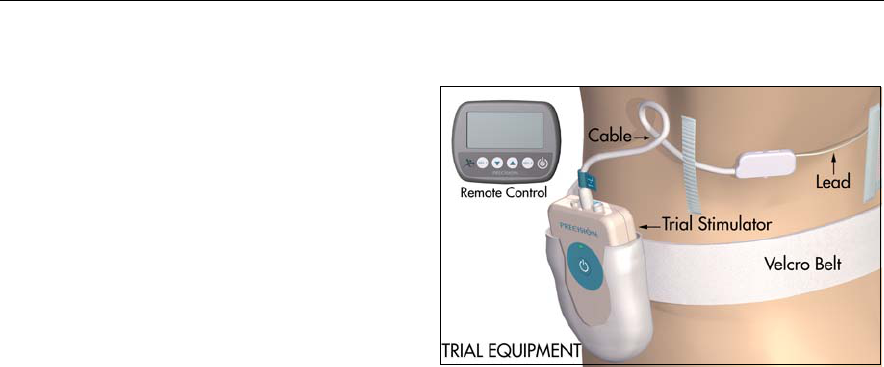
Patient Trial Handbook
8
Using the Medical Equipment
The Trial Stimulator System
The Trial Stimulator is a temporary external
spinal cord stimulator that is connected to the
lead(s) placed along the spinal cord. You will
use this external system to test how effective
stimulation is in relieving your pain.
The Trial System includes:
•Lead—An implantable cable that
sends stimulation pulses to the
spinal cord.
•Remote Control—A small battery
powered computer used to adjust
stimulation.
•Cable(s)—Thin plastic cable(s) used to attach the Trial Stimulator to the lead.
•Velc ro® Belt—A belt used to hold the Trial Stimulator (optional).
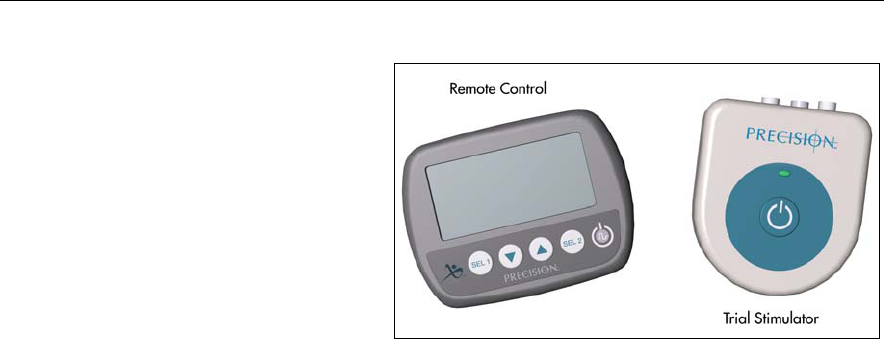
Using the Medical Equipment
9
Taking Care of Your Trial Equipment
All of the items that were sent home with
you from the hospital are important to your
trial success. So please follow the
instructions listed.
• Handle the Trial Stimulator and the
Remote Control with care. These
items are well-designed, quality-
tested electronic components.
However, they can be damaged if
they’re dropped on a hard surface.
• Never submerge the Trial Stimulator
or the Remote Control in water, or leave them outside in the rain, extreme heat, or extreme cold.
• Always turn off the Trial Stimulator, remove it from the belt pocket, and disconnect and secure
the leads before taking a sponge bath.
• Carry your Temporary Patient Identification card (given to you by your healthcare provider)
throughout the trial.
Note: This information covers most of what you need to be aware of during the trial. For additional
precautionary information, see “Safety Instructions” on page 22. Please read the section
carefully.
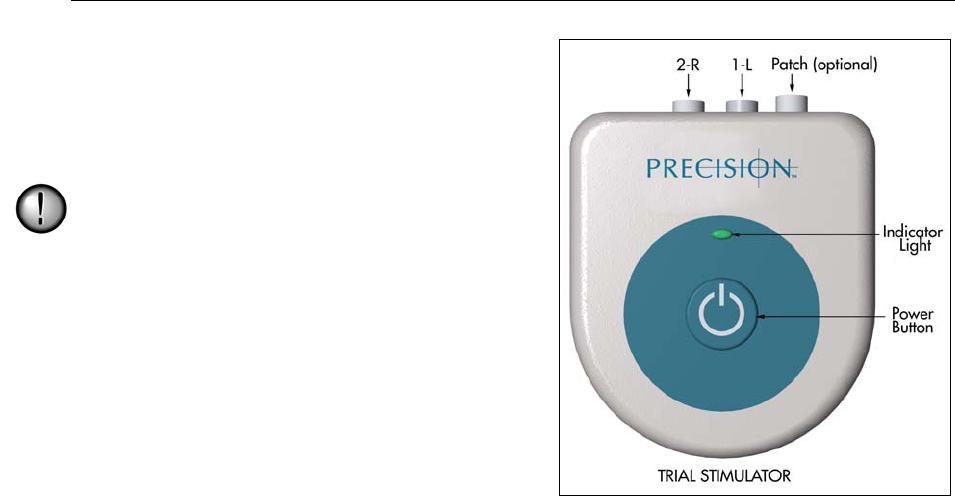
Patient Trial Handbook
10
The Trial Stimulator
You may turn off the Trial Stimulator by pressing its
power on/off button, or by pressing the power button
on the Remote Control unit. When the stimulator is
on, the indicator light will blink
Always turn the stimulator off before connecting or
disconnecting your lead wires.
Disconnecting the Trial Stimulator
The Trial Stimulator has connectors for both left and
right leads, and a third connector for a patch
electrode. Whether you have one or two leads, your
doctor probably placed identifying labels on the lead
wires before connecting them to matching plugs on
the stimulator. These labels are intended to make it as
easy as possible for you to connect the wires properly.
Remember to check the label(s) each time you need to
reconnect the leads.
Note: If you were given a patch electrode for stimulation, an extra one is provided in case the
adhesive wears out. When connecting a new patch electrode, be sure to plug it securely into
the connector.
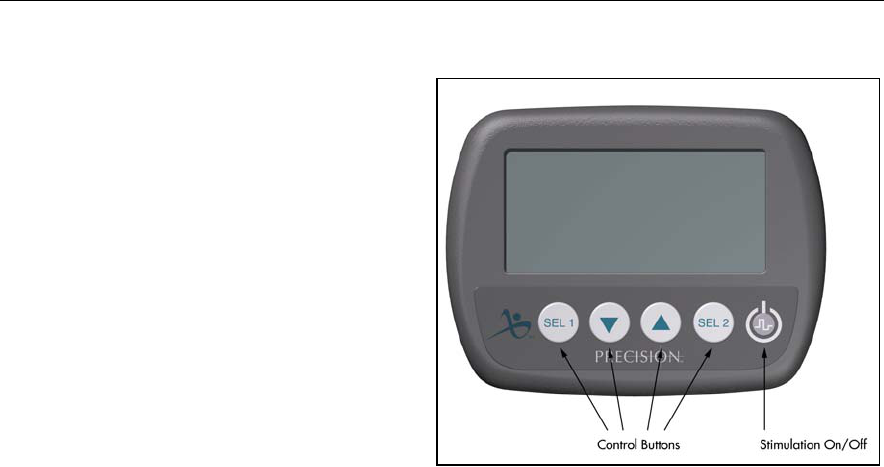
Using the Medical Equipment
11
The Remote Control
The Remote Control unit is your direct link to
choices available for tailoring spinal cord
stimulation to suit your comfort and
convenience requirements. Keep the Remote
Control with you at all times in a pocket, purse,
or in your immediate vicinity.
The Remote Control is used to:
• Turn stimulation ON and OFF
• Change stimulation levels
• Activate or save new programs
Each button function label shown on the screen
is related to the control button below it.

Patient Trial Handbook
12
Basic Operation
When it is not being used the Remote Control is in a “sleep” mode. Press any button and the Remote
Control will wake up and look for the stimulator. Once connected, you can make adjustments. When
you are done, the Remote Control will go to sleep after 60 seconds.
Good communication between the implant and the Remote Control is very important. This is the
reason you’ll often see the message “Connecting...” while you are adjusting the stimulation. This is
normal because the Remote Control continually checks for the stimulator.
Note: If you have trouble communicating with the stimulator, the message “No Response” will
appear on the Remote Control screen. See “Help” on page 26 for more information.
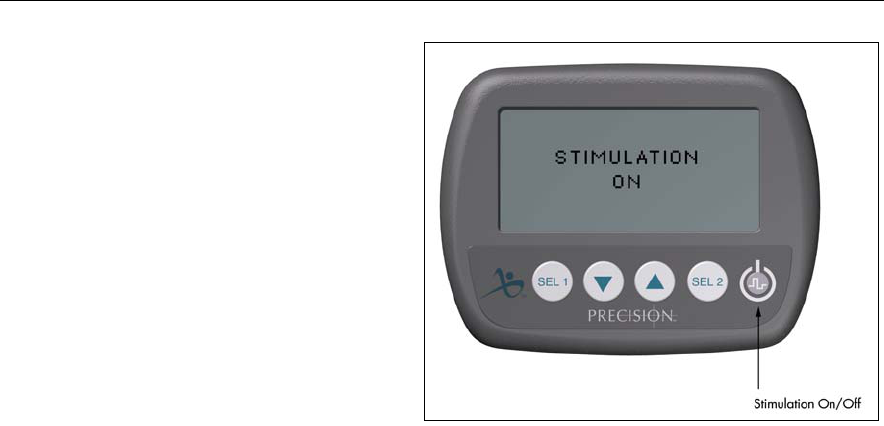
Using the Medical Equipment
13
Stimulation On and Off
The Remote Control uses a “dedicated”
stimulation on/off switch. You may press the
stimulation power button at any time to
immediately turn stimulation on or off. You
don’t have to be concerned about whether or
not the Remote Control is awake.
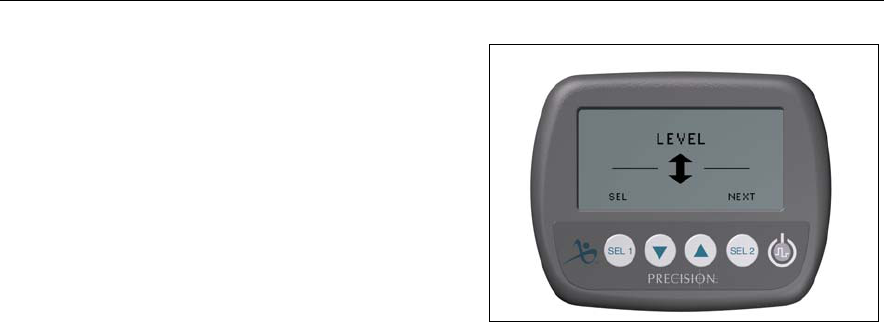
Patient Trial Handbook
14
Stimulation Level Control
A few seconds after stimulation is turned on, the
Remote Control displays the main screen. From here,
you may press the [down] or [up] button to
adjust the stimulation level (or intensity) until you’re
comfortable. The main screen controls all stimulation,
whether you have one area of pain control... or more
than one.
Note: • In some cases, health professionals can give
you control over more than one stimulation
area.
•Multiple area control is available only if
your system has been programmed to deliver
stimulation to separate areas. If you do not
have separate area control (for example, left
leg vs.right leg) but feel that separate control
might improve your stimulation therapy,
speak to your health professional about this
at your next visit.
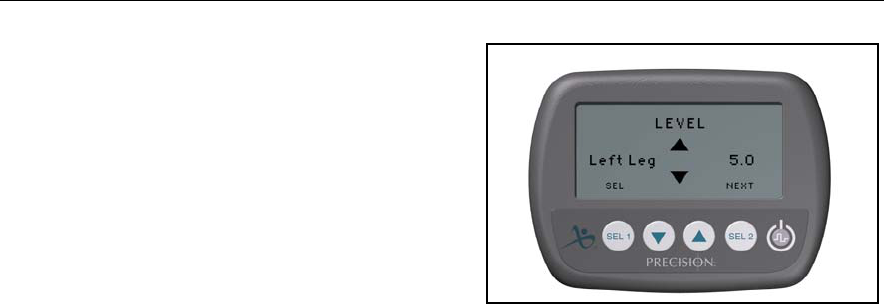
Using the Medical Equipment
15
Selecting Areas (for Stimulation Control)
1. From the main screen, press the SEL 1 button as
necessary to cycle through your programmed
areas. Each area is given a number (1 through 4)
or a name, for example LeftArm.
Note: If you only have one area of control, then that
one area will appear each time you press SEL 1.
2. When the named or numbered area that you want
to adjust is displayed, press or to change
the stimulation level for that area.

Patient Trial Handbook
16
Selecting Programs (for Stimulation Control)
Your Remote Control can store up to four stimulation programs which may have been set up by your
healthcare professional. Each saved program will have certain differences in the settings. These
differences allow you to vary your stimulation in many ways. You may have been encouraged to try
and compare specific programs for different circumstances or times in your daily routine. This is
especially helpful during the trial period. Program flexibility gives you and your healthcare
professional a way to continually “fine-tune” your therapy.
To select and activate programs:
1. Press the SEL 2 [NEXT] button from the main screen to go to the program screen.
2. Press the SEL 1 [SEL] button as necessary to choose the program you want to activate.
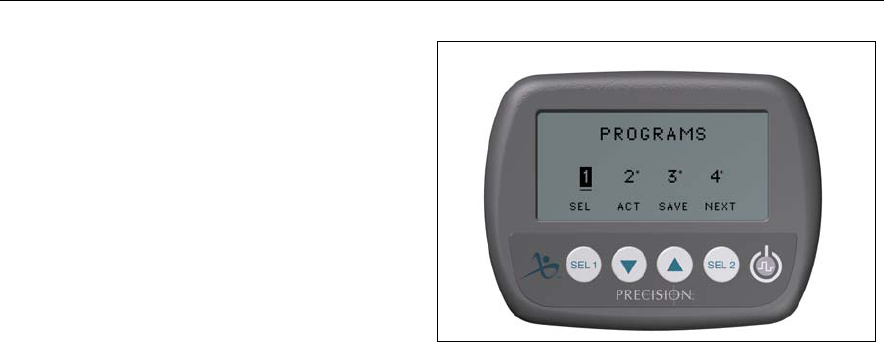
Using the Medical Equipment
17
3. Once the desired program is highlighted,
press [ACT] and that program will start
running after a couple of seconds.
Note: You might not have all four programs
saved in your Remote Control. Empty
program slots will have an * (asterisk)
symbol beside the program number. If
you try to activate an empty program,
nothing will happen.
Once you’ve selected and activated a program,
you can adjust its stimulation level using the
and buttons.
If you make a stimulation level adjustment and
decide that you prefer it, go back and select the
program again, then press [SAVE]. The
program will be updated with the new level.
You may also save changes to any empty (*) program slot if one is available.

Patient Trial Handbook
18
Battery Information
Remote Control:
Following the low battery message you will only be
able to turn the implant on and off. If you try to use
any button except the power button, you will be
reminded “Replace Remote Battery ON/OFF ONLY.”
The battery for your Remote Control is a special 3.6-volt battery
available only from Advanced Bionics. Do not attempt to use a
1.5-volt AA battery in the Remote Control.
If you do not have an extra battery in your Trial Kit, call
Advanced Bionics Customer Service Department at (866) 566-
8913 to request a new battery.
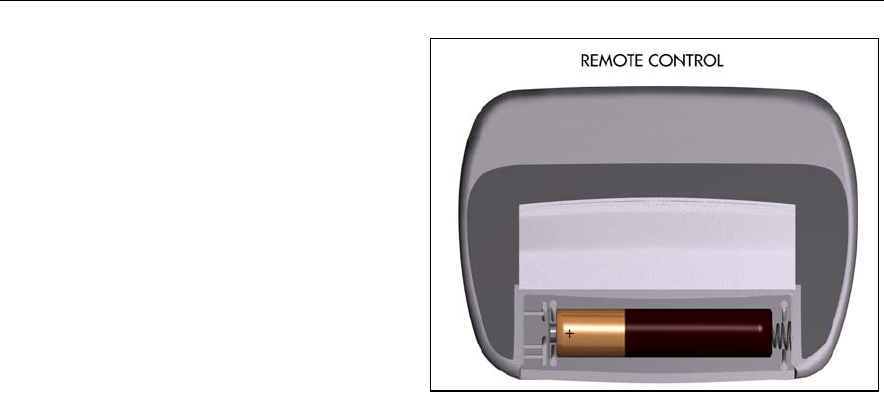
Using the Medical Equipment
19
To replace the Remote Control battery
1. On the rear of the remote, slide the battery
compartment lock lever to the left to unlock
the cover.
2. Press down on the ridged area below the
lever using your thumb to release the cover.
3. Open the cover and remove the old battery.
4. Replace the new battery in the slot,
matching the positive and negative
markings.
5. Close the compartment by sliding the lock
lever to the right.
The Remote Control will connect and reload information from the stimulator in approximately 30
seconds.
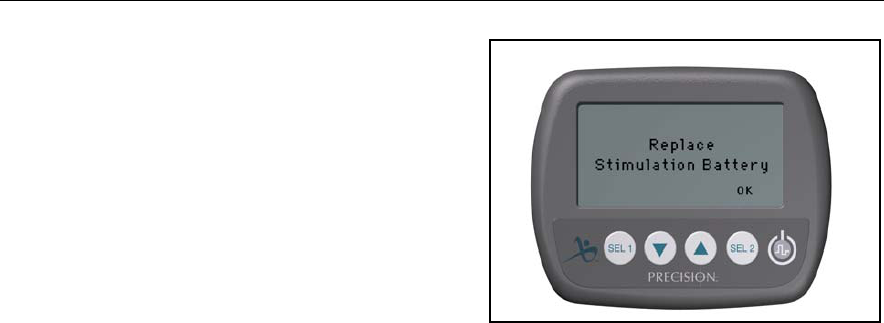
Patient Trial Handbook
20
Trial Stimulator:
If the message “REPLACE STIMULATION BAT-
TERY” appears on the Remote Control screen accom-
panied by a three-beep alarm, press SEL2 [OK] to
acknowledge the message, then install a new battery
right away.
The battery for your Trial Stimulator is a 6-volt
battery (lithium Duracell 28L). This type of battery
can be purchased at most drug and convenience
stores.
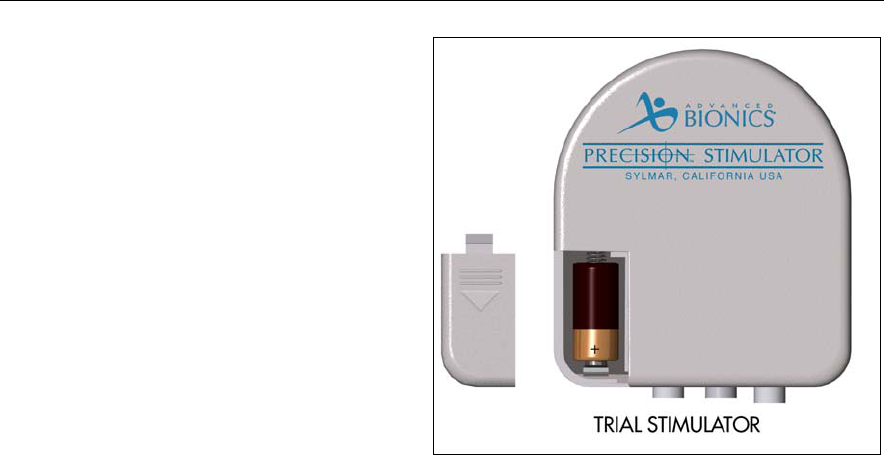
Using the Medical Equipment
21
To replace the Trial Stimulator battery:
1. On the rear of the unit, press down on the
ridged area and slide to release the cover.
2. Open the cover and remove the old battery.
3. Replace the new battery in the slot,
matching the positive and negative
markings.
4. Close the compartment by sliding the cover
in the opposite direction.

Patient Trial Handbook
22
Safety Instructions
Warnings
Pregnancy. The safety considerations of SCS devices for use during pregnancy are unknown. If you
become pregnant, turn off the External Trial Simulator when you become aware of your condition
and consult your physician.
Diathermy. As an SCS patient, you must not have any form of diathermy either as treatment for a
medical condition or as part of a surgical procedure. The high energy and heat generated by
diathermy can be transferred through the leads, causing tissue damage at the lead site and, possibly,
severe injury or death.
Posture. Some changes in posture may cause decreased or uncomfortable increased stimulation
levels. Keep the Remote Control with you at all times in order to be ready to adjust stimulation for
unexpected changes.
Electromagnetic Interference. Avoid or exercise care around electromagnetic fields generated by:
• Theft detectors and security screeners (usually located at stores, airports, libraries, and
government buildings)
• Power lines and power generators
• Electric steel furnaces, arc welders, and other heavy duty industrial electric equipment

Safety Instructions
23
• Large magnetized stereo speakers.
As you approach these devices you may become aware of changing stimulation levels. In rare
instances, you could experience an increase in stimulation level to the point that the sensation is
uncomfortably strong or possibly “jolting.” If this happens, turn off the External Trial Stimulator. If
the stimulator suddenly turns off by itself, first move away from the area. Next, check the
stimulation status with the Remote Control by pressing the power button and observing the screen.
Always be aware of your surroundings, particularly near theft detectors/security screeners. Ask for
assistance to go around these devices if you feel at all uncomfortable.
Precautions
MRI. You mu st not be exposed to Magnetic Resonance Imaging (MRI). Exposure to this diagnostic
technology may result in dislodgement of your lead(s) and/or increased voltage through the leads
which can cause an uncomfortable or “jolting” sensation.
Medical Devices/Therapies. The following medical therapies or procedures may turn stimulation
off or may cause permanent damage to the Trial Stimulator, particularly if used in close proximity to
the device:
• lithotripsy
• electrocautery

Patient Trial Handbook
24
• external defribrillation
• radiation therapy
• ultrasonic scanning
• high-output ultrasound
Before having procedures, medical therapies, or diagnostics, have your healthcare professional call
our Customer Service department at (866) 566-8913 for proper instructions.
Automobiles and Other Equipment. Do not operate an automobile, other motorized vehicle, or
potentially dangerous machinery/equipment with stimulation turned on. Turn off stimulation first.
Sudden stimulation changes, if they occur, may distract you from attentive operation of the vehicle
or equipment.

Adverse Effects
25
Adverse Effects
Potential risks are involved with any surgery. The possible risks of implanting a pulse generator as
part of a system to deliver spinal cord stimulation include:
• Lead migration, resulting in undesirable changes in stimulation and subsequent
reduction in pain relief.
• System failure, which can occur at any time due to random failure(s) of the components
or the battery. These events, which may include device failure, lead breakage, hardware
malfunctions, loose connections, electrical shorts or open circuits and lead insulation
breaches, can result in ineffective pain control.
• Tissue reaction to implanted materials can occur.
• Skin erosion at the IPG site can occur over time.
• Possible surgical procedural risks are: temporary pain at the implant site, infection,
cerebrospinal fluid (CSF) leakage and, although rare, epidural hemorrhage, seroma,
hematoma and paralysis.
• External sources of electromagnetic interference may cause the device to malfunction
and affect stimulation.
• Exposure to MRI can result in heating of tissue, image artifacts, induced voltages in the
neurostimulator and/or leads, lead dislodgement.

Patient Trial Handbook
26
Help
Stimulation
No Stimulation
1. When stimulating, the Trial Stimulator status light will blink. If it is not blinking, toggle the
power button on the Trial Stimulator or the Remote Control. When the Remote Control receives
confirmation from the Trial Stimulator, it will flash “Stimulation On.”
2. When the status light is blinking and you still do not feel stimulation:
a. Check to make sure the lead cable is properly connected to the stimulator. Turn the stim-
ulator “off” before adjusting the cables, and then turn it back “on.”
b. If you were provided a skin patch electrode, check that it is properly secured to your
skin. Make sure to turn the stimulation off first, and then back on.
c. Try turning up the level of the stimulation. If this does not bring on stimulation, turn it
back down.
3. When the status light will not blink and you do not feel stimulation, replace the Trial Stimulator
battery.
4. Call your physician’s office if the above steps do not solve the problem.

Help
27
Stimulation Increases or Decreases on Its Own
1. Stimulation can change depending on body position (lying down, standing or bending).
2. Always keep the Remote Control with you, so that you can adjust your stimulation levels as
needed.
Stimulation Coverage is in a Different Area Than at the Doctor’s Office
1. If stimulation is moved, and you did not activate a different program, you should call your
doctor. It is possible that the leads may have moved during the trial.
Remote Control Display
“Remote Battery Low” on the Display
1. The battery in your Remote Control needs to be replaced using the Advanced Bionics 3.6 Volt
battery. Do not use a AA battery. Call Advanced Bionics Customer Service department at (866)
566-8913 or your physician’s office to obtain a new battery.
“No Response” on the Display
1. When the Remote Control displays “No Response,” it cannot find the Trial Stimulator because
of orientation or interference. Move the remote closer and try again. Call our Customer Service
Department at (866) 566-8913 if the problem continues.

Patient Trial Handbook
28
“Action Unsuccessful” on the Display
1. When the Remote Control displays “Action Unsuccessful,” press [OK] and try the action again.
If pressing [OK] does not clear the message, call your physician’s office.
Accessories
Washing the Velcro® Belt
1. Wash the belt with mild soap and warm water.

Help
29
Contacting Advanced Bionics
If you have any other questions, or need to contact Advanced Bionics for any reason, you may do so
in any of the following ways:
• Customer Service Phone: (866) 566-8913
• Customer Service Fax: (661) 362-1503
• Address: Advanced Bionics® Corporation
Pain Management Division
Mann Biomedical Park
25129 Rye Canyon Loop
Valencia CA 91355

Patient Trial Handbook
30

CORPORATE HEADQUARTERS
Advanced Bionics®Corporation
12740 San Fernando Road, Sylmar, CA 91342
(800) 678-2575 in US and Canada
(818) 362-7588, (818) 362-5069 Fax
(800) 678-3575 TTY
www.advancedbionics.com
Email:info@advancedbionics.com
PAIN MANAGEMENT DIVISION
Advanced Bionics®Corporation
Mann Biomedical Park
25129 Rye Canyon Loop, Valencia, CA 91355
(661) 362-1400, (661) 1500 Fax
JUN03-080620-P ©2003 Advanced Bionics Corp. All rights reserved.
9055078 Rev C
IMAGINE the Possibilities®